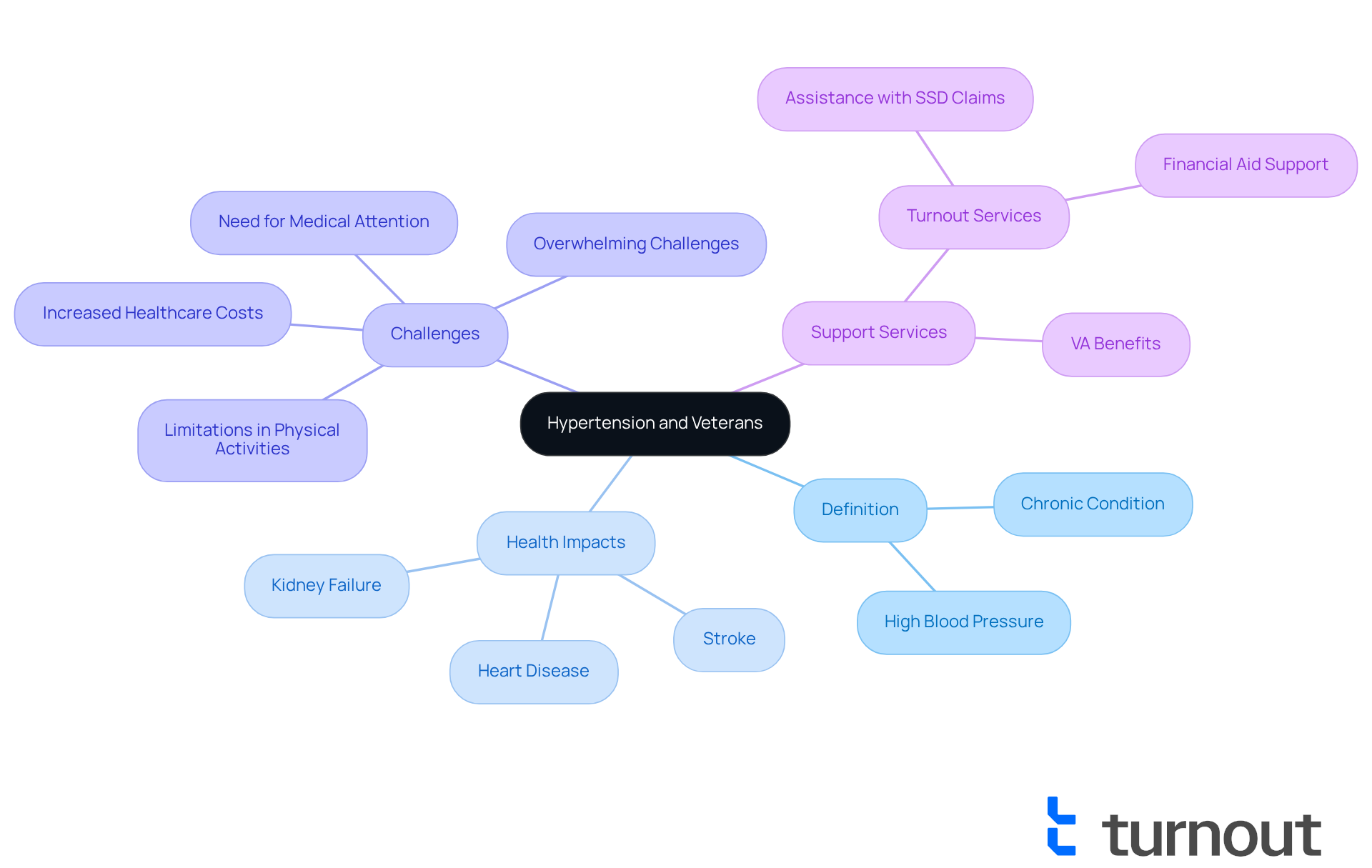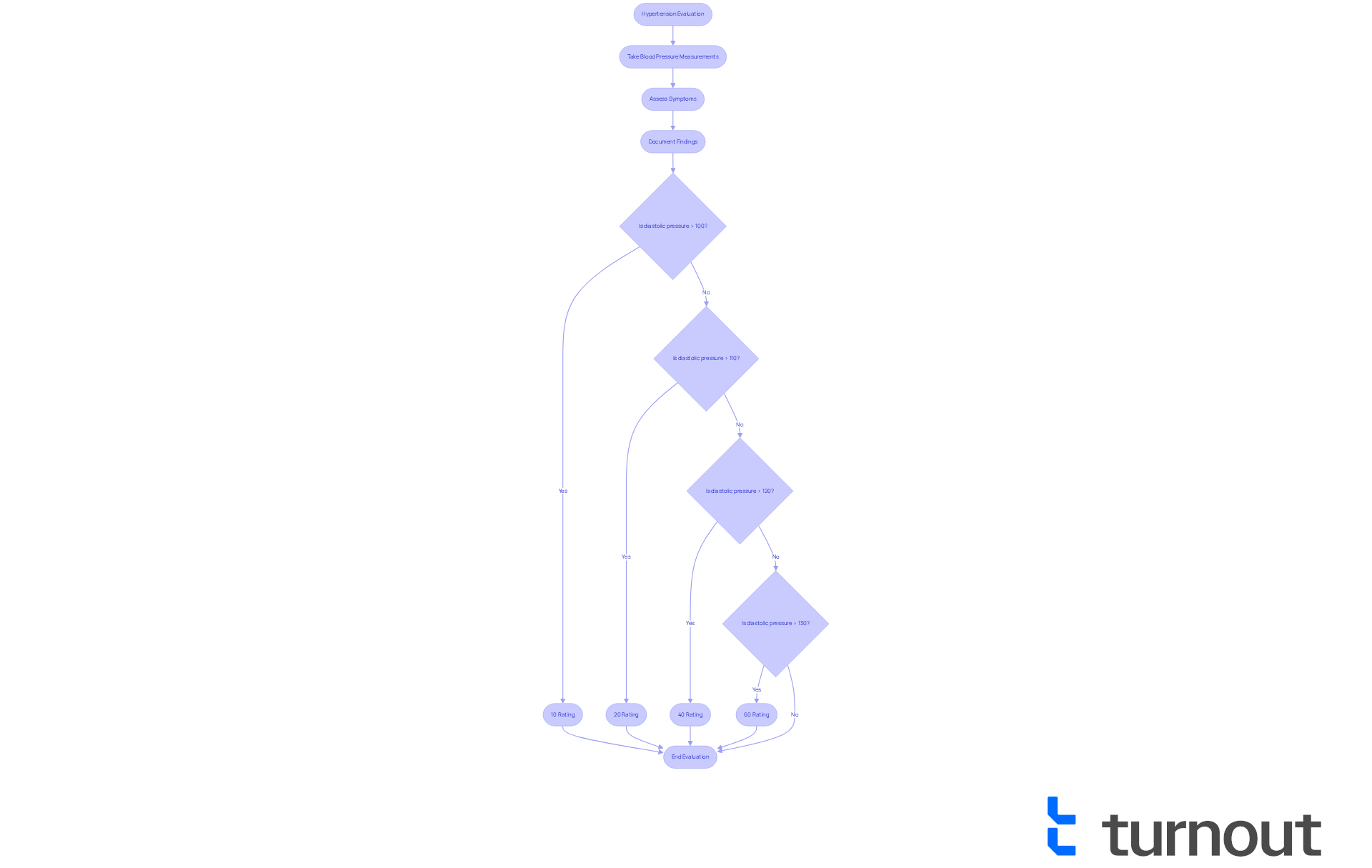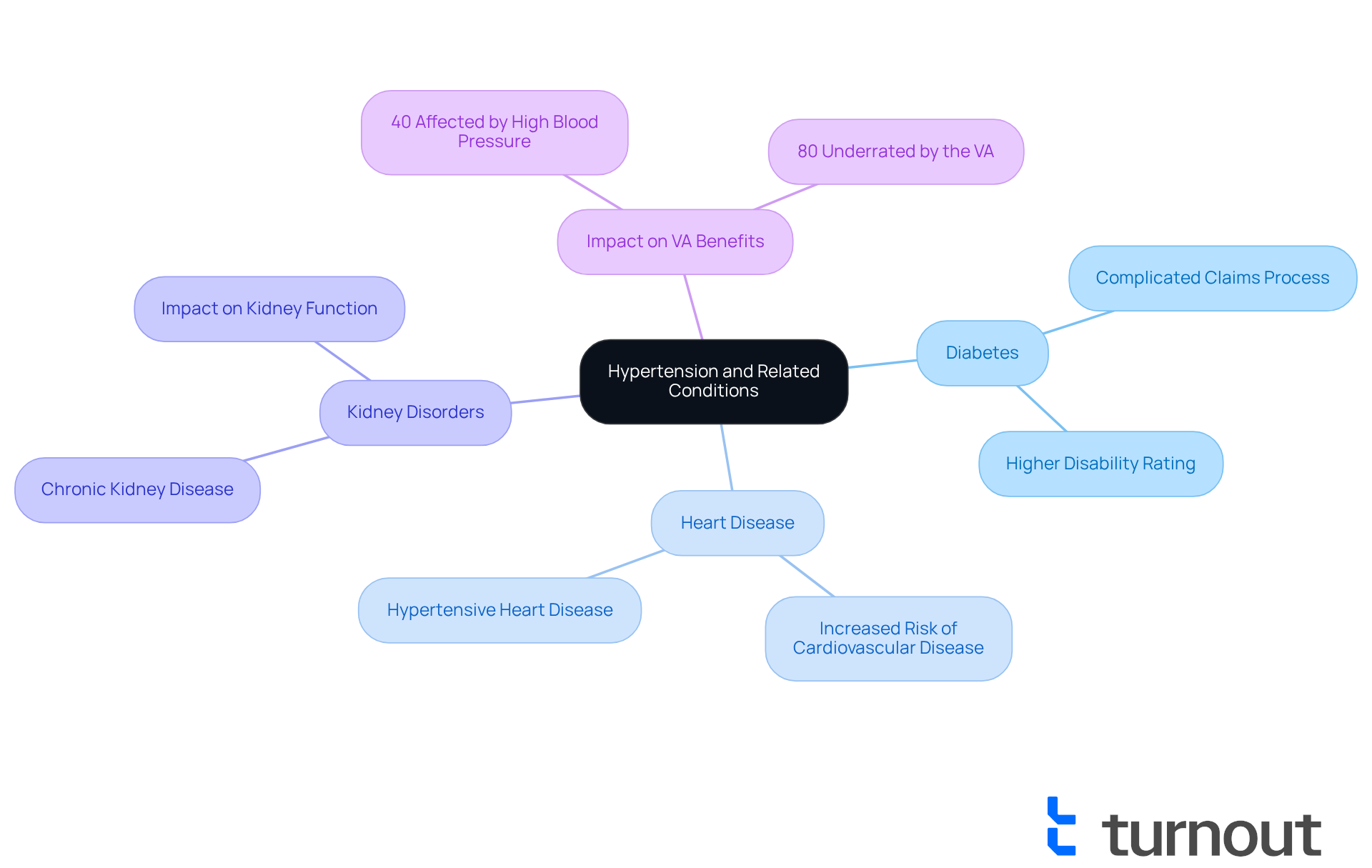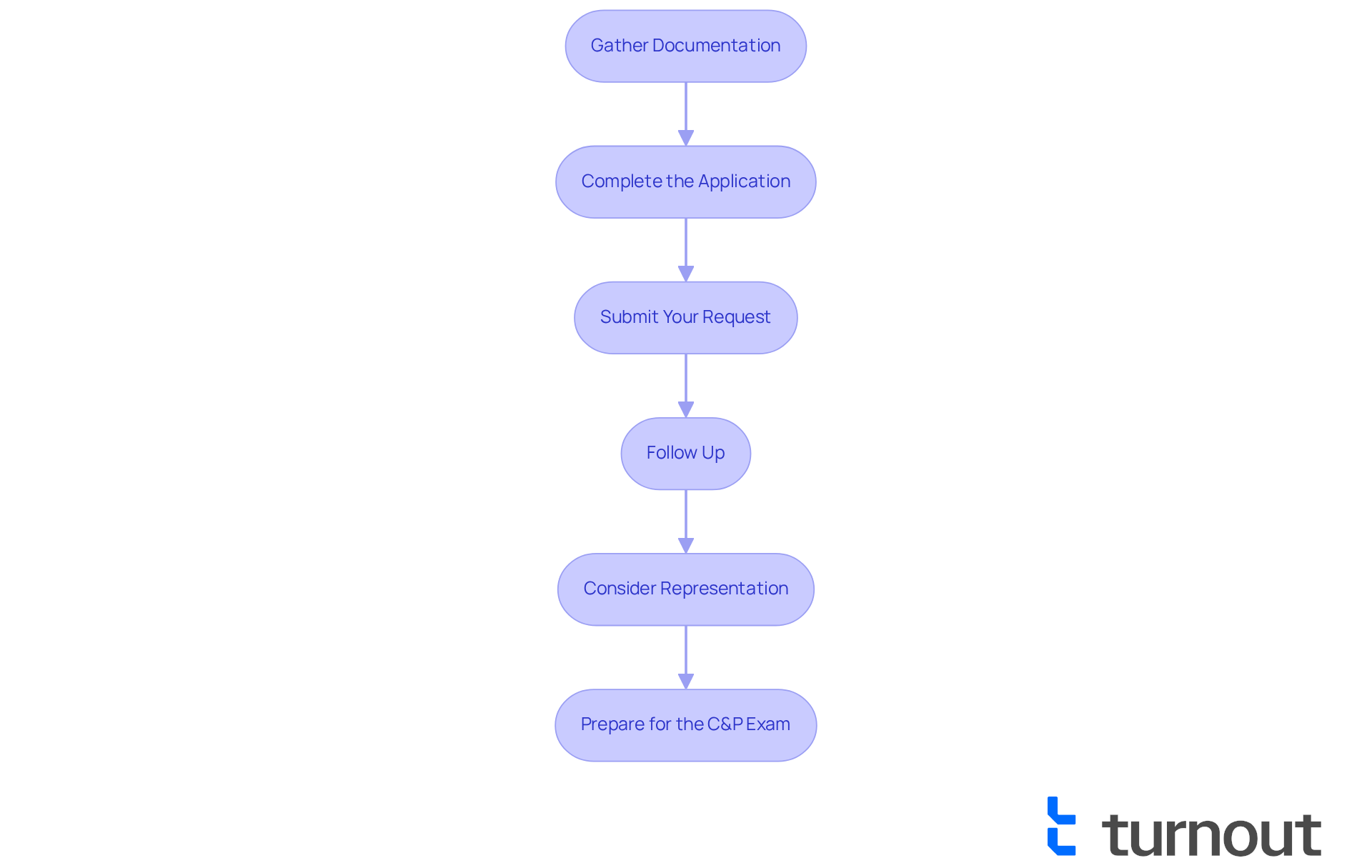Overview
The main focus of this article is to serve as a comprehensive guide for veterans navigating the process of obtaining a VA rating for high blood pressure. We understand that this can be a daunting task, and we aim to address your concerns by providing clear definitions, discussing the impact of hypertension, outlining rating criteria, and identifying related health conditions. Additionally, we will walk you through the essential steps for filing a claim.
Hypertension has significant health implications for veterans, and it's vital to recognize how it can affect your life. This article details the specific VA rating criteria based on blood pressure measurements and symptoms, ensuring you have the information you need. We also offer a step-by-step approach to successfully navigating the claims process, emphasizing the importance of thorough documentation and support.
Remember, you are not alone in this journey. We’re here to help you every step of the way.
Introduction
Hypertension, or high blood pressure, presents a serious health risk, especially for veterans who may already be facing various service-related medical challenges. We understand that navigating these issues can be overwhelming. Recognizing the implications of hypertension is crucial, as it can significantly affect a veteran's quality of life and their eligibility for vital VA benefits.
With nearly 40% of former military personnel affected by this condition, the stakes are high. Yet, many veterans remain unaware of how to effectively navigate the VA rating process for hypertension. It's common to feel lost in this complex health challenge.
How can veterans ensure they receive the support they need while managing their health? We're here to help you find the answers.
Define Hypertension and Its Impact on Veterans
Hypertension, commonly known as high blood pressure, is a chronic condition that can lead to serious health complications, including heart disease, stroke, and kidney failure. We understand that for former service members, the effects of high blood pressure can be particularly significant, especially as many may already be managing other health concerns linked to their service. Comprehending high blood pressure is crucial for former service members, as it can impact their quality of life and their eligibility for the VA rating for high blood pressure benefits.
Veterans with hypertension often face limitations in physical activities, increased healthcare costs, and a greater need for medical attention. These factors can influence their overall health and financial stability. It's common to feel overwhelmed by these challenges, but recognizing them is the first step in advocating for the necessary support and benefits available through the VA.
Turnout provides valuable tools and services aimed at assisting former service members in navigating these complex systems. We offer support with SSD claims and financial aid without requiring professional legal help. This approach simplifies access to government benefits and financial support, ensuring that veterans receive the help they need to manage their health and financial well-being. Remember, you are not alone in this journey—we're here to help.

Explore VA Rating Criteria for Hypertension
Understanding hypertension can be overwhelming, especially when considering its impact on daily life. The evaluation of this condition by the VA rating for high blood pressure is based on its severity and how it affects your functioning. Ratings are assigned through specific blood flow measurements and the presence of related symptoms like headaches, dizziness, or fatigue. Veterans may receive ratings of 0%, 10%, 20%, 40%, or even higher, depending on their blood circulation readings and symptom frequency.
For example, if your diastolic levels consistently exceed 100, you might qualify for a higher rating. A 10% rating is given when diastolic pressure is 100 or higher, or if systolic pressure is mainly 160 or higher, or if there’s a history of diastolic pressure at 100 or more that requires continuous medication. As of 2025, a 10% rating results in monthly compensation of $175.51, while a 60% rating provides $1,395.93 per month.
Comprehending these criteria is essential, as they directly influence the benefits you may receive, including healthcare coverage and financial assistance. We encourage you to gather all relevant medical documentation and records to strengthen your submissions effectively.
It’s important to note that high blood pressure is recognized as a presumptive condition for veterans exposed to Agent Orange. This acknowledgment simplifies the claims process for those diagnosed within one year of active duty release. Prompt and precise medical assessments are crucial, as consistent blood measurements taken on at least three different days are necessary for determining a current diagnosis.
The VA rating for high blood pressure is assessed using Diagnostic Code 7101 in the VA Schedule for Rating Disabilities. Keeping thorough documentation of your blood pressure measurements and symptoms is vital for enhancing your VA rating for high blood pressure, as it provides essential proof to support your requests. Remember, you are not alone in this journey; we’re here to help you navigate through these challenges.

Examine the Connection Between Hypertension and Related Conditions
Hypertension is often linked with various other health conditions, such as diabetes, heart disease, and kidney disorders. We understand that for former service members, these comorbidities can significantly complicate overall well-being and impact VA benefits. For instance, a veteran diagnosed with both high blood pressure and diabetes may face more severe health challenges, potentially leading to a higher disability rating.
The VA rating for high blood pressure recognizes that this condition can serve as a secondary issue to other service-related injuries or illnesses, thus opening up additional avenues for claims. It’s essential for former service members to recognize these connections and ensure that all related health issues are thoroughly documented in their submissions. This comprehensive approach not only provides a clearer picture of their health status but can also be crucial in securing the benefits they deserve.
Data indicates that nearly 40% of former military personnel are affected by high blood pressure, and many also contend with other health issues that complicate their claims process. For example, individuals with both high blood pressure and diabetes often face increased risks for cardiovascular disease, which can exacerbate their health problems and affect their eligibility for a VA rating for high blood pressure.
Moreover, it’s important to highlight that 80% of former service members are underrated by the VA, underscoring the need for detailed documentation. Hypertensive heart disease is a serious complication that can arise from unmanaged high blood pressure, and cognitive impairment is another potential outcome that veterans should remain aware of.
By understanding and articulating these relationships in their claims, veterans can more effectively advocate for their health needs and improve their chances of obtaining the compensation they rightfully deserve. Remember, you are not alone in this journey; we’re here to help you navigate these challenges.

Guide to Filing a VA Claim for Hypertension
Filing a VA rating for high blood pressure can feel overwhelming, but we're here to guide you through the process with care and understanding. Here are the key steps to help you advocate for your rights and access the benefits you deserve:
-
Gather Documentation: Begin by collecting all relevant medical records, including diagnoses, treatment history, and any related conditions. Consistent blood pressure readings and treatment records are essential to support your claim for a VA rating for high blood pressure. Remember, a lack of medical evidence is a common reason for VA disability requests being denied.
-
Complete the Application: Use VA Form 21-526EZ to apply for disability compensation. Make sure to fill out all sections accurately, providing detailed information about your hypertension and how it affects your daily life. A strong claim often includes a current medical diagnosis and a nexus letter connecting your condition to military service.
-
Submit Your Request: You can file your request online through the VA's website, by mail, or in person at a VA regional office. Ensure you include all necessary documentation to avoid delays. It's common to feel anxious about this step, but taking it is crucial.
-
Follow Up: After submission, monitor the status of your request through the VA's online portal or by contacting their office. Be prepared to provide further details if needed, as the VA aims to handle requests within 125 days. However, more complex situations may take additional time.
-
Consider Representation: While not mandatory, having a knowledgeable representative can significantly strengthen your request. They can guide you on documentation and help navigate any complexities in the process. Many veterans find that support enhances their chances of a successful application.
-
Prepare for the C&P Exam: Be aware that a Compensation and Pension (C&P) examination will be part of the claims process. This exam assesses the severity of your high blood pressure and reviews your medical history. It's important to share how high blood pressure impacts your daily life, including any related symptoms or complications, while also discussing the VA rating for high blood pressure.
By following these steps, you can effectively advocate for yourself. Remember, documenting changes in symptoms and blood pressure readings is vital, especially if you need to request a higher rating due to worsening hypertension. Understanding the VA rating for high blood pressure, which varies from 10% to 60% based on specific blood pressure thresholds, can also help you gauge the potential outcome of your claim. You are not alone in this journey; we’re here to help you every step of the way.

Conclusion
Hypertension, or high blood pressure, is a serious health concern that impacts many veterans, often complicating their overall well-being and access to essential benefits. We understand that navigating the intricacies of the VA rating for high blood pressure can be daunting. Recognizing the significance of hypertension and its potential effects on daily life is vital for veterans. By doing so, you can better advocate for yourself and ensure you receive the benefits you deserve.
This article has explored key aspects of hypertension, including:
- Its definition
- The VA rating criteria
- The connection to related health conditions
- A step-by-step guide to filing a VA claim
It's important to emphasize thorough documentation; this can strengthen your claims and improve your chances of receiving appropriate ratings and benefits. With nearly 40% of former military personnel affected by high blood pressure, understanding these elements is crucial for effective advocacy.
Ultimately, the journey to securing VA benefits for high blood pressure requires diligence and support. We encourage you to take proactive steps in documenting your health conditions and seeking assistance when needed. By doing so, you not only enhance your chances of obtaining the compensation you rightfully deserve but also contribute to a broader awareness of the challenges faced by your peers. Remember, you are not alone in this journey—there are resources available to help navigate this process, ensuring that no veteran has to face these challenges alone.
Frequently Asked Questions
What is hypertension?
Hypertension, commonly known as high blood pressure, is a chronic condition that can lead to serious health complications such as heart disease, stroke, and kidney failure.
Why is hypertension particularly significant for veterans?
For veterans, hypertension can be especially impactful as many may already be managing other health concerns linked to their service, which can affect their quality of life and eligibility for VA benefits related to high blood pressure.
What challenges do veterans with hypertension face?
Veterans with hypertension often experience limitations in physical activities, increased healthcare costs, and a greater need for medical attention, which can influence their overall health and financial stability.
How can veterans seek support for managing hypertension?
Veterans can seek support through organizations like Turnout, which provides tools and services to help them navigate complex systems, including assistance with SSD claims and financial aid without the need for professional legal help.
What resources are available for veterans dealing with hypertension?
Resources include support services offered by organizations like Turnout, which aim to simplify access to government benefits and financial support for veterans managing their health and financial well-being.




